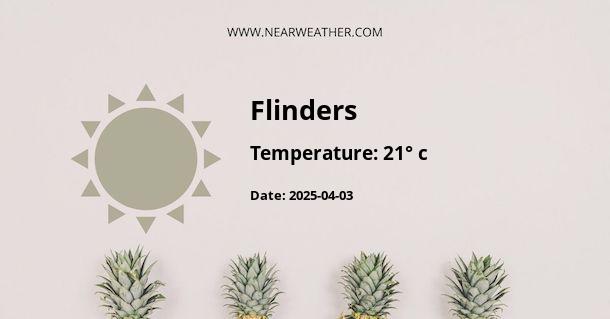Weather
15° 
Climate Conditions: overcast clouds
Humidity: 89%
Wind speed: 7.34 km/h
Wind direction: 203°
Daily Weather Forecast
Saturday
04/26/2025
Climate Conditions: light rain
Humidity: 88%
Sunday
04/27/2025
Climate Conditions: few clouds
Humidity: 79%
Monday
04/28/2025
Climate Conditions: overcast clouds
Humidity: 72%
Tuesday
04/29/2025
Climate Conditions: overcast clouds
Humidity: 82%
Wednesday
04/30/2025
Climate Conditions: scattered clouds
Humidity: 79%
Evolution
Daily Weather Forecast Evolution (°C)
Lowest temperature
Highest temperature
Other Information
Sunrise
06:56
Sunset
17:38
Latitude
-38.466671
Longitude
145.016663
Timezone: GMT+05:30
More about Flinders:
Climate and Weather in Flinders, Australia
Flinders, a suburb located in the Mornington Peninsula of Victoria, Australia, experiences a unique climate characterized by mild temperatures, distinct seasons, and a relatively high amount of rainfall throughout the year. This article explores the climate and weather patterns in Flinders, providing detailed information about temperature ranges, precipitation levels, and seasonal variations.Temperature
Flinders enjoys a moderate and comfortable climate, with temperatures that rarely reach extreme levels. The average annual temperature in Flinders is around 16 degrees Celsius (61 degrees Fahrenheit). However, there are noticeable differences in temperature between the summer and winter months. During the summer season, which typically spans from December to February, temperatures in Flinders can vary between 20 to 30 degrees Celsius (68 to 86 degrees Fahrenheit). The hottest month is usually January, with average highs reaching around 27 degrees Celsius (81 degrees Fahrenheit). The nights are generally cooler, with temperatures dropping to around 14 degrees Celsius (57 degrees Fahrenheit). In winter, which lasts from June to August, temperatures in Flinders tend to be cooler, ranging from 8 to 15 degrees Celsius (46 to 59 degrees Fahrenheit). The coldest month is usually July, with average lows around 7 degrees Celsius (45 degrees Fahrenheit). Despite the lower temperatures, it is rare for Flinders to experience frost or snowfall.Precipitation
Flinders receives a significant amount of rainfall throughout the year, contributing to its lush and green landscapes. The average annual precipitation in Flinders is approximately 850 millimeters (33.5 inches). Rainfall is relatively evenly distributed across the months, although some variations can be observed. The wettest months in Flinders are typically during the winter season, with July and August receiving the highest levels of rainfall. During these months, Flinders can experience around 100 millimeters (4 inches) of rainfall each month. Spring, which spans from September to November, also sees a fair amount of rainfall, with an average of 70 to 80 millimeters (2.8 to 3.2 inches) per month. Summer and autumn are relatively drier in Flinders, with average monthly precipitation ranging from 40 to 60 millimeters (1.6 to 2.4 inches). However, it is worth noting that occasional thunderstorms can occur during the summer months, bringing short but intense periods of rainfall.Seasonal Variations
Flinders experiences distinct seasons throughout the year, each with its own characteristics and weather patterns. Summer, as mentioned earlier, is warm and relatively dry. It is a popular time for outdoor activities, such as swimming and beach visits, as temperatures are pleasant and the coastal areas offer refreshing sea breezes. Autumn, from March to May, sees mild temperatures and less rainfall compared to the winter months. The changing colors of the foliage in the surrounding countryside make this season particularly picturesque. Winter brings cooler temperatures and higher rainfall. While it is not uncommon to have rainy days during this season, the mild climate of Flinders means that snowfall and frost are rare occurrences. Spring is a transitional season characterized by blossoming flowers and milder temperatures. It is a great time to explore the local gardens and enjoy outdoor activities before the heat of summer arrives.Conclusion
Flinders, Australia, enjoys a moderate climate with distinct seasons. The suburb experiences mild temperatures throughout the year, with average highs ranging from 20 to 30 degrees Celsius (68 to 86 degrees Fahrenheit) in summer and average lows of 8 to 15 degrees Celsius (46 to 59 degrees Fahrenheit) in winter. Flinders receives a significant amount of rainfall, with an average of 850 millimeters (33.5 inches) annually. The wettest months are during winter, while summer and autumn tend to be drier. Overall, Flinders offers a pleasant climate for residents and visitors alike, with a variety of activities to enjoy throughout the seasons.References:
- Bureau of Meteorology, Australia - Climate-Data.orgFAQ's about Flinders's Weather:
Q - What is the Latitude and Longitude of Flinders?
A - Flinders's Latitude is -38.466671 & Longitude is 145.016663.
Q - What is the weather in Flinders today?
A - Weather in Flinders is 15° today.
Q - What is the climatic condition of Flinders today?
A - Climate Conditions in Flinders shows overcast clouds today.
Q - What is the humidity in Flinders today?
A - Humidity in Flinders is 89% today.
Q - What is the wind speed in Flinders today?
A - Wind speed in Flinders is 7.34 km/h, flowing at 203° wind direction. today.

Nearby Locations
Latest searched locations